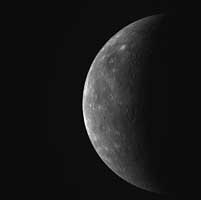|
COMETS EARTH JUPITER KUIPER BELT MARS MERCURY METEORITES NEPTUNE OORT CLOUD PLUTO SATURN SOLAR SYSTEM SPACE SUN URANUS VENUS ORDER PRINTS
PHOTO CATEGORIES SCIENCEVIEWS AMERICAN INDIAN AMPHIBIANS BIRDS BUGS FINE ART FOSSILS THE ISLANDS HISTORICAL PHOTOS MAMMALS OTHER PARKS PLANTS RELIGIOUS REPTILES SCIENCEVIEWS PRINTS
|
Related Documents
Download Options
Date Acquired: September 29, 2009 Yesterday, as the spacecraft approached Mercury for the mission's third flyby of the Solar Systemís innermost planet, MESSENGER captured this striking view. This WAC image shows portions of Mercury's surface that had remained unseen by spacecraft even after the three flybys by Mariner 10 in 1974-75 and MESSENGER's two earlier flybys in 2008. In this image, just returned to Earth early this morning, the newly imaged terrain is located in a wide vertical strip near the limb of the planet (on the left side of Mercuryís partially sunlit disk). Viewing the image coverage map from before the flyby provides more information on the location of the newly seen area. This WAC image is just one of 11 taken through the camera's narrow-band color filters, and this set of images will be used to examine color differences on Mercury's surface and to learn about the evolution of crustal rocks on the planet. Credit: NASA/Johns Hopkins University Applied Physics Laboratory/Carnegie Institution of Washington |
